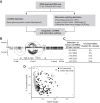Cardiac circRNAs arise mainly from constitutive exons rather than alternatively spliced exons
- PMID: 29567830
- PMCID: PMC5959250
- DOI: 10.1261/rna.064394.117
Cardiac circRNAs arise mainly from constitutive exons rather than alternatively spliced exons
Abstract
Circular RNAs (circRNAs) are a relatively new class of RNA molecules, and knowledge about their biogenesis and function is still in its infancy. It was recently shown that alternative splicing underlies the formation of circular RNAs (circRNA) arising from the Titin (TTN) gene. Since the main mechanism by which circRNAs are formed is still unclear, we hypothesized that alternative splicing, and in particular exon skipping, is a major driver of circRNA production. We performed RNA sequencing on human and mouse hearts, mapped alternative splicing events, and overlaid these with expressed circRNAs at exon-level resolution. In addition, we performed RNA sequencing on hearts of Rbm20 KO mice to address how important Rbm20-mediated alternative splicing is in the production of cardiac circRNAs. In human and mouse hearts, we show that cardiac circRNAs are mostly (∼90%) produced from constitutive exons and less (∼10%) from alternatively spliced exons. In Rbm20 KO hearts, we identified 38 differentially expressed circRNAs of which 12 were produced from the Ttn gene. Even though Ttn appeared the most prominent target of Rbm20 for circularization, we also detected Rbm20-dependent circRNAs arising from other genes including Fan1, Stk39, Xdh, Bcl2l13, and Sorbs1 Interestingly, only Ttn circRNAs seemed to arise from Rbm20-mediated skipped exons. In conclusion, cardiac circRNAs are mostly derived from constitutive exons, suggesting that these circRNAs are generated at the expense of their linear counterpart and that circRNA production impacts the accumulation of the linear mRNA.
Keywords: Rbm20; circRNAs; gene expression; heart; splicing.
© 2018 Aufiero et al.; Published by Cold Spring Harbor Laboratory Press for the RNA Society.
Figures




References
-
- Ashwal-Fluss R, Meyer M, Pamudurti NR, Ivanov A, Bartok O, Hanan M, Evantal N, Memczak S, Rajewsky N, Kadener S. 2014. circRNA biogenesis competes with pre-mRNA splicing. Mol Cell 56: 55–66. - PubMed
-
- Beqqali A, Bollen IAE, Rasmussen TB, van den Hoogenhof MM, van Deutekom HWM, Schafer S, Haas J, Meder B, Sørensen KE, van Oort RJ, et al. 2016. A mutation in the glutamate-rich region of RNA-binding motif protein 20 causes dilated cardiomyopathy through missplicing of titin and impaired Frank-Starling mechanism. Cardiovasc Res 112: 452–463. - PubMed
Publication types
MeSH terms
Substances
LinkOut - more resources
Full Text Sources
Other Literature Sources
Molecular Biology Databases
Research Materials
Miscellaneous
